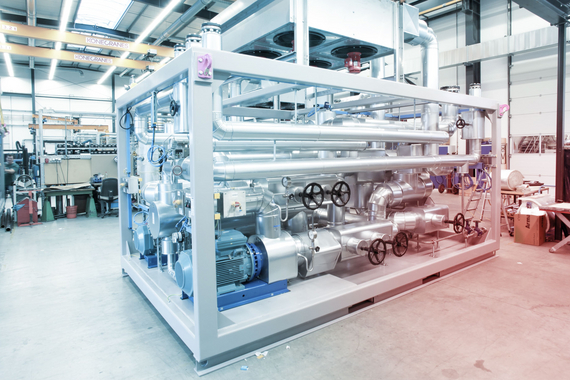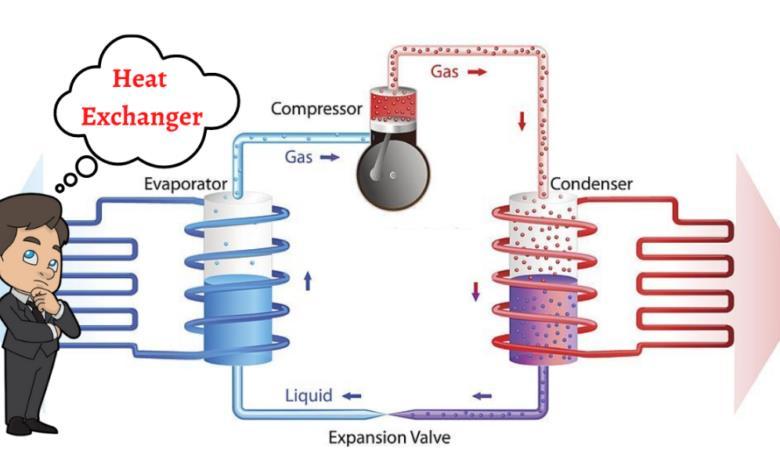How DVS Heat Transfer Systems Use Nanotechnology to Outperform Traditional Cooling Systems
Developments in Heat Transfer Solutions: What You Need to Know for Optimal Performance
Advancements in Heat transfer systems are transforming performance throughout numerous industries. Advanced products like graphene and nanofluids promise significant enhancements in thermal conductivity. The assimilation of IoT and maker understanding uses possibilities for real-time monitoring and boosted energy effectiveness. The landscape of thermal monitoring is swiftly evolving. Understanding these growths is vital for achieving optimal system efficiency and sustainability in the future. What certain innovations are forming this improvement?
Emerging Products for Enhanced Heat Transfer

Advanced Heat Exchanger Layouts
While conventional Heat exchangers have offered their purpose in numerous applications, advanced styles are now emerging to fulfill the enhancing needs for performance and efficiency. These ingenious layouts, such as plate, shell-and-tube, and finned-tube Heat exchangers, integrate improved area and enhanced flow patterns to boost thermal transfer prices. In enhancement, portable designs enable decreased room needs without endangering efficiency. Advanced materials, such as compounds and corrosion-resistant alloys, additionally boost longevity and performance under extreme conditions. In addition, simulation technologies and computational liquid dynamics are increasingly utilized to improve these layouts, making sure peak Heat transfer features. As markets seek to decrease energy consumption and take full advantage of outcome, the fostering of advanced Heat exchanger designs is critical in attaining these objectives.
The Duty of Nanotechnology in Heat Transfer
Nanotechnology plays an important duty in enhancing thermal conductivity within Heat transfer systems. By adjusting products at the nanoscale, scientists have actually attained substantial renovations in energy performance. These advancements not just optimize performance but additionally add to even more lasting energy services.
Enhanced Thermal Conductivity
Significant improvements in thermal conductivity have arised via the application of nanotechnology, changing Heat transfer systems across various industries. By incorporating nanoparticles right into Heat transfer liquids and products, researchers have actually accomplished remarkable increases in thermal conductivity. These nanoparticles, such as carbon nanotubes, graphene, and metal oxides, enhance the Heat transfer residential or commercial properties as a result of their high area and special thermal characteristics. The resulting composites display improved efficiency in applications ranging from electronics cooling down systems to eco-friendly energy innovations. Furthermore, the capacity to tailor the size, shape, and make-up of nanoparticles enables optimized thermal administration services. Therefore, nanotechnology remains to play an essential role in the growth of much more reliable and reliable Heat transfer systems, leading the means for enhanced industrial applications.
Power Efficiency Improvements

Assimilation of IoT in Heat Transfer Equipments
The integration of IoT in Heat transfer systems presents the implementation of clever sensors that enhance functional effectiveness. These sensors allow real-time information tracking, enabling for instant modifications and optimizations. This technological improvement has the possible to significantly enhance efficiency and power monitoring in Heat transfer applications.
Smart Sensors Implementation
As Heat transfer systems evolve, the integration of clever sensing units with the Internet of Things (IoT) has arised as a transformative strategy. These sensors make it possible for real-time surveillance of circulation, temperature level, and pressure prices, improving system efficiency and integrity. By collecting and sending information, they assist in proactive upkeep, lowering the threat of system failings. Furthermore, smart sensing units add to power savings by refining functional criteria based on ecological problems. Their capability to examine abnormalities and patterns permits notified decision-making, making sure peak performance of Heat transfer systems. As industries significantly adopt this innovation, the execution of clever sensors stands to transform just how Heat transfer systems are handled, leading the means for better sustainability and enhanced efficiency end results.
Real-Time Information Monitoring
How can real-time data keeping an eye on improve the performance of Heat transfer systems? By integrating Internet of Things (IoT) technology, Heat transfer systems can leverage continual data collection from clever sensors. This real-time monitoring enables instant evaluation of circulation, temperature level, and stress rates, enabling operators to recognize inadequacies without delay. Consequently, changes can be made to enhance efficiency, lower energy usage, and prolong devices life expectancy. Furthermore, predictive maintenance can be executed, reducing unexpected downtime and costly repair services. The ability to envision performance metrics through dashboards enhances decision-making, cultivating a proactive technique to system management. Inevitably, real-time data keeping an eye on not just enhances functional efficiency but additionally contributes to sustainability goals within industrial processes.
Energy Performance and Sustainability Trends
Power performance and sustainability patterns are reshaping the landscape of Heat transfer systems, driving innovation and compliance throughout different industries. Organizations are significantly prioritizing energy-efficient layouts to reduce operational prices and lessen ecological influences. The integration of renewable resource resources is coming to be more widespread, enabling Heat transfer systems to operate sustainably while fulfilling governing requirements. In addition, improvements in technologies and materials promote lower power usage and enhance overall efficiency. Lifecycle analyses are additionally obtaining grip, permitting companies to evaluate the ecological effect of Heat transfer systems from manufacturing to disposal. This concentrate on sustainability not just supports company duty yet likewise settings companies competitively in a market where customers progressively favor eco-friendly remedies. Subsequently, energy effectiveness and sustainability continue to be critical considerations for future advancements in Heat transfer modern technology.
Advancements in Thermal Monitoring Solutions
While the demand for efficient Heat transfer remains to climb, advancements in thermal administration solutions are emerging to deal with both performance and sustainability challenges. Advanced products, such as phase modification products and nanofluids, are being established to improve Heat transfer efficiency - DVS Heat Transfer Systems. These materials enhance thermal conductivity and permit for much better temperature regulation in various applications. Furthermore, technologies like active thermal control systems are obtaining grip, allowing real-time modifications to take care of Heat flow efficiently. These systems add to energy savings and decrease the environmental effect of thermal procedures. The integration of IoT in thermal administration helps with monitoring and predictive maintenance, making sure maximized performance and longevity of Heat transfer systems. In general, these technologies stand for considerable strides towards even more sustainable thermal administration techniques
Future Directions in Heat Transfer Technology
Arising innovations in thermal administration remedies signify an basics appealing future for Heat transfer modern technology. Researchers are significantly concentrating on creating materials with superior thermal conductivity and enhanced energy effectiveness. Advancements such as nanofluids, which have put on hold nanoparticles, use visit this site substantial enhancements in Heat transfer performance. In addition, the assimilation of clever materials that adapt to varying temperature conditions is gaining traction, permitting more reliable and responsive systems. The rise of additive manufacturing strategies is also making it possible for the style of intricate Heat exchanger geometries that enhance liquid circulation. The execution of device understanding algorithms is anticipated to change the optimization of Heat transfer systems, assisting in anticipating maintenance and performance enhancement. Collectively, these developments are poised to transform the landscape of Heat transfer modern technologies in various industries.

Frequently Asked Inquiries

Just how Do I Select the Right Heat Transfer System for My Application?
Picking the ideal Heat transfer system includes examining application demands, including temperature level ranges, liquid residential or commercial properties, and effectiveness requirements. Examining system kinds, maintenance factors to consider, and cost-effectiveness also plays an important duty in making an educated decision.
What Are the Maintenance Needs for Advanced Heat Exchangers?
Upkeep requirements for innovative Heat exchangers commonly consist of normal assessments, monitoring for leakages, cleansing of surface areas, and guaranteeing suitable flow rates. Sticking to manufacturer standards guarantees effective operation and lengthens the tools's life expectancy.
Exactly How Do Ecological Factors Affect Heat Transfer Performance?
Ecological factors considerably affect Heat transfer effectiveness. Variations in temperature level, airflow, and moisture impact thermal conductivity and convective Heat transfer, inevitably influencing system efficiency and demanding consideration throughout the style and operation of Heat transfer systems.
What Safety And Security Criteria Put On Heat Transfer Systems?
Security standards for Heat transfer systems typically consist of standards from organizations such as ASME and ASTM. DVS Heat Transfer Systems. These requirements address products, layout, and operational methods to assure integrity, performance, and defense versus hazards in numerous applications
How Can I Troubleshoot Common Heat Transfer System Issues?
Fixing typical Heat transfer system issues includes inspecting for leaks, guaranteeing proper liquid circulation, inspecting insulation stability, and validating temperature level differentials. Determining these variables can assist preserve system effectiveness and avoid more issues.
Nanotechnology plays a necessary role in improving thermal conductivity within Heat transfer systems. Substantial innovations in thermal conductivity have arised with the application of nanotechnology, revolutionizing Heat transfer systems across numerous industries. Improvements in thermal conductivity with nanotechnology have paved the way for exceptional renovations in energy performance within Heat transfer systems. Energy effectiveness and sustainability patterns are improving the landscape of Heat transfer systems, driving development and conformity across various industries. The integration of IoT in thermal monitoring assists in monitoring my review here and predictive maintenance, making certain optimized performance and long life of Heat transfer systems.